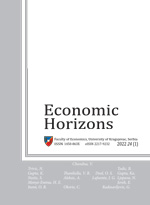EFFECTS OF THE IMPLEMENTATION OF THE INFLATION TARGETING REGIME ON ECONOMIC GROWTH
Suzana Stevanovic1, Ivan Milenkovic2 and Sladjana Paunovic3
1University of East Sarajevo, Faculty of Business Economics in Bijeljina, Bosnia and Herzegovina
2University of Novi Sad, Faculty of Economics in Subotica, the Republic of Serbia
3University of East Sarajevo, Faculty of Economics in Pale, Bosnia and Herzegovina
This research study is focused on the examination of the influence of the introduction and implementation of the monetary Inflation Targeting (IT) regime: the level of the inflation rate and the Gross Domestic Product (GDP) growth rate, as well as inflation and the GDP volatility. Conditional variance is calculated by fitting an empirical Generalized Autoregressive Conditional Heteroskedasticity (GARCH) model to an annualized quarterly date for the period from 1993Q1 to 2020Q3, all in order to assess volatility. The results of the regression model showed that there was a positive statistical significance between the instability of inflation and the instability of the growth rate of the GDP in the three analyzed countries (namely in Albania, Turkey and the Republic of Serbia). The result of introducing the IT regime when the GDP growth rate volatility is concerned is statistically significant in Serbia and Turkey and led to reduction in the GDP volatility and stabilization. However, the applied regression model indicated that, in the case of Albania and Romania, the introduction of the IT regime did not have a statistically significant impact on the GDP growth rate volatility.
Keywords: inflation targeting, economic growth, GARCH, regression model
JEL Classification: C32, E47, O11, O42




